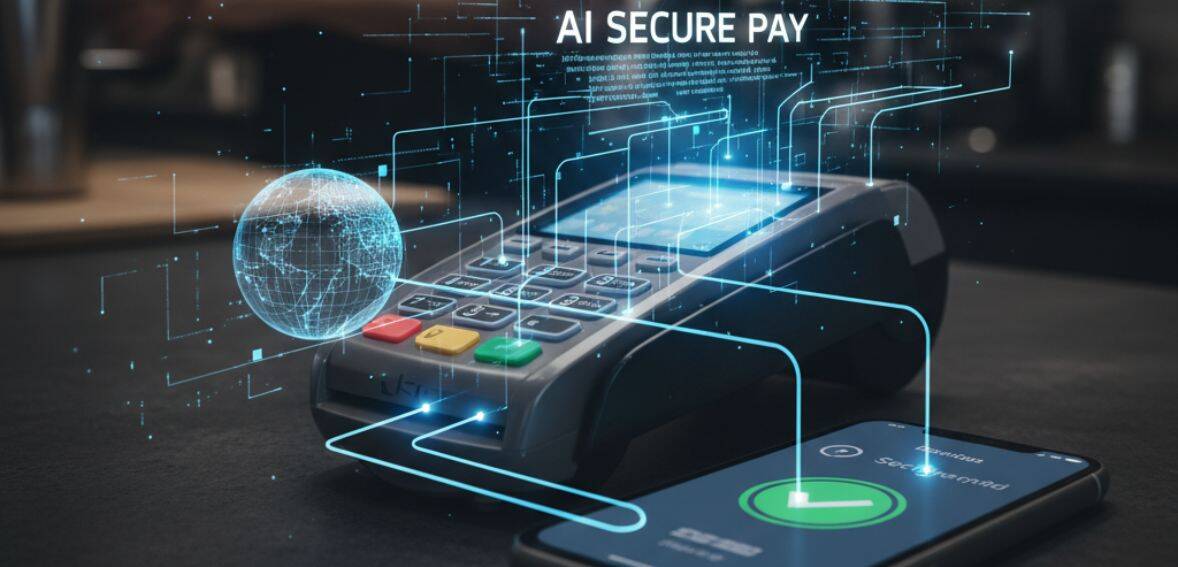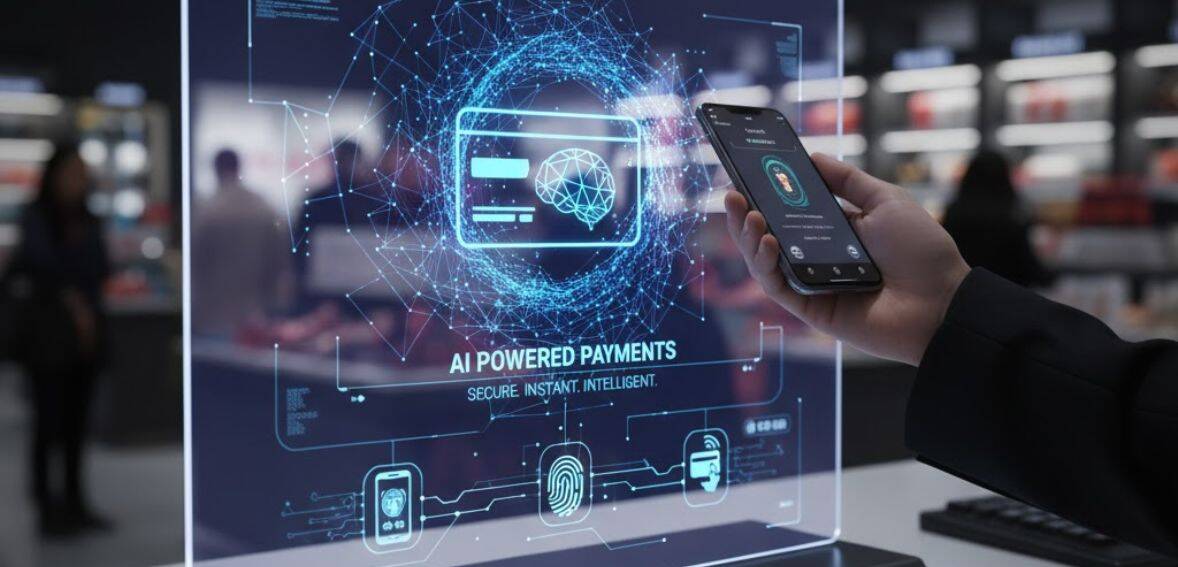
By OliviaMorgan October 23, 2025
Artificial intelligence and machine learning are transforming payment processing into more secure, more efficient, and more accurate transactions. They make it possible to automate routine operations, avoid fraud, and eliminate errors. Businesses can better personalize customers’ experiences, gain insights from payment information, and optimize the processes.
Artificial intelligence and machine learning increase much more efficiency, cut costs, and improve better satisfaction, making businesses competitive in the changing digital payments landscape.
Common AI Tools and Technologies Used in the Online Payments Industry

1. Machine Learning (ML)
Machine learning drives most of the payment innovation. It handles a very very large volume of transaction data and identifies patterns and suspicious behavior in real time. This enables businesses to stop fraud before it occurs.
ML is applied to enhance personalization of customers by preference and spending habits, enabling companies to develop customized offers.
2. Natural Language Processing (NLP)
NLP allows computers to understand and respond to human language, making it much more essential for voice and chat-based payments. Customers can now complete transactions just by speaking to a virtual assistant or chatbot.
NLP-driven chatbots are also available around the clock to answer questions, assist with payments, or solve issues without the need for human support. Additionally, NLP can enable analyzing customer reviews and feedback to let businesses know what their users are thinking and how they can improve better.
3. Biometric Authentication
Security is always a priority with electronic payments, and biometrics provides considerably improved heightened security. Facial recognition and fingerprinting enable more rapid logging or verifying a transaction with passwords and provide better enhanced security.
Voice recognition is a rapidly emerging alternative, enabling systems to recognize users based on unique voice patterns. These technologies all make it considerably more difficult for an unauthorized person to gain access to accounts or perform fraudulent transactions.
4. Blockchain Technology
Blockchain is more important in increasing transparency and security in payment systems. Blockchain operates by recording data on an electronic ledger that cannot be altered, eradicating fraud or tampering.
Smart contracts are blockchain’s most valuable use in payments for executing and verifying transactions based on predefined conditions automatically.
5. Data Analytics
Each electronic payment generates valuable information. Businesses can examine this data to uncover more better informed patterns and trends. Such insights inform businesses what customers are spending, where they can make processes more efficient, and tailor offers according to spending behavior.
Analytics also facilitate better decision-making by exposing what works and where the effectiveness of payment systems can be maximized in the system.
6. Generative AI
Generative AI is one of the new technologies to revolutionize customer experience. It has the ability to generate realistic and personalized content like personalized emails, product promotions, or payment reminders. It enhances customer interaction through intelligent chat responses that are natural-sounding and conversational in tone.
With the identification of customer behavior and preferences and customization of communication in real-time, generative AI enables organizations to form more engaging customer relationships and enhance satisfaction.
Key Areas Where AI Is Revolutionizing Digital Payments

AI is revolutionizing the way digital payments occur by making them quicker, smarter, and secure. From preventing fraud to enhancing more personalized customer experiences, AI has a pivotal role in enhancing the way customers and businesses manage transactions.
First and foremost, fraud prevention and detection is probably the strongest application of AI for payments. AI can rapidly screen thousands of transactions and discover anything out of the ordinary. For instance, if a card makes huge payments in a foreign nation where it is not supposed to, machine learning software can immediately flag the behavior as suspicious and notify the bank. This avoids the fraud from occurring, protecting both the consumer and companies.
Secondly, AI also facilitates and personalizes payments by watching how people shop and pay, and can even suggest payment methods, discounts, or rewards depending on the shopping behavior of each person. For example, an AI system can offer a payment plan that aligns with a customer’s shopping pattern, making it convenient and rewarding for customers. This individualization enhances stronger loyalty and confidence.
Thirdly, functions such as processing bills, making payments, or reconciling transactions are all straightforwardly carried out by AI systems. These automations eliminate human errors, accelerate payments, and enable employees to concentrate on crucial activities. Through the services of these companies, we save time and have consistency in operations.
Let us not forget that AI also enables improved risk management and credit scoring. With reference to transaction history and shopping behavior, AI can provide more precise credit scores. This helps banks and lenders to make better judgments about whom to lend or grant credit to. It also reduces risks through data analysis.
Further, AI is revolutionizing Know Your Customer (KYC) procedures. Rather than physically verifying customer documents manually, AI applications can cross-reference data in databases within seconds to verify identities. This accelerates the onboarding process and renders it significantly more efficient and accurate, as well as assists businesses in fulfilling compliance. It also minimizes the threat of identity fraud and theft.
AI is also raising the accuracy of approvals on transactions. Authentic transactions are often incorrectly rejected because of outdated technology. Machine learning is utilized to recognize authentic spending behavior, lowering false declines and preventing real customers from being disrupted when attempting to make a purchase.
AI has also enhanced Interactive Voice Response (IVR) payment systems, commonly used in customer support. With AI integration, these systems can now handle simple payment requests automatically, offer round-the-clock assistance, and escalate complex issues when needed. This creates a smoother experience for customers and reduces the load on support staff.
AI vs Traditional Payment

Feature | AI-Powered Payments | Traditional Payments |
Transaction Speed | 1-5 seconds per transaction | 1-3 days for cross-border transfers |
Error Rate | <0.5% due to automated verification | 2-5% due to manual entry errors |
Fraud Detection | Real-time monitoring, 95% detection accuracy | Reactive, 60-70% detection accuracy |
Cost Efficiency | 20-40% lower operational costs due to automation | Higher operational costs with manual processes |
Customer Support | 24/7 AI chatbots and virtual assistants | Limited support hours, human staff required |
Personalization | AI analyzes behavior for tailored offers | Minimal, generic promotions |
Cross-Border Processing | 1-2 hours average using AI optimization | 2-5 days average, higher fees |
Compliance & Security | Continuous real-time checks, automated alerts | Periodic checks, higher risk of human error |
Benefits of AI in Digital Payments
AI is revolutionizing online payments by making systems more efficient, intelligent, and secure, providing advantages in the areas of efficiency, customer care, and accuracy. It boosts productivity by automating routine tasks like invoice processing, data entry, and transaction classification so that employees can focus on higher-order tasks.
The workflows are accelerated with AI performing repetitive or complicated tasks, reducing errors and speeding up operations, allowing businesses to respond promptly and save costs. Secondly, customer service is also improved by AI-based chatbots and virtual assistants that offer 24/7 assistance and personalized suggestions.
Fraud and possible threats are recognized in real time, safeguarding systems and transactions. Human error is also minimized by the consistent application of correct algorithms and learning from patterns in the past, leading to greater accuracy, reliability, and smoother payment processing as a whole.
AI Revolutionizing Cross-Border Payments

Cross-border payments are an essential component of the international economy, facilitating businesses to pay for foreign trade and individuals to send money across the world. Conventional mechanisms are slow, expensive, and less efficient. Artificial intelligence and machine learning are revolutionizing that by accelerating payments, reducing expenses, and enhancing security.
AI accelerates payments by rapidly processing payment information, allowing money to reach its destination more quickly. This works especially well for companies that need timely international payments to sustain supply chains and build relationships with foreign partners. Secondly, AI also reduces expenses by performing currency exchange and regulatory checks.
Security and regulatory adherence are another sector where AI takes the lead. Cross-border transactions also need to adhere to tight controls and anti-money laundering policies. AI oversees payments in real-time, detecting questionable trends and ensuring customers and businesses are protected. By adopting this proactive measure, fraud is avoided, and financial systems around the world become more secure.
Challenges in Leveraging AI in Digital Payments

AI is transforming digital payments, but it also has some challenges that companies must be very mindful of. The most significant challenge, perhaps, is data security and privacy. AI processes usually require access to extensive customer and transaction data, posing more higher risks of unauthorized access, data breaches, or misuse of data.
Secondly, biased algorithms are another issue. AI may turn out to be biased in payment approval decisions and transaction routing when it is trained on biased past data, and this may affect some customers in a negative manner. Thirdly, another issue is regulatory compliance. Banks need to make sure that AI systems comply with all the legal regulations, i.e., repetitive checks, reporting, and well-defined practices.
Let’s not forget integration issues could render it very hard to implement. Integrating AI into current payment systems requires very high technical skills, appropriate management of data, and better transparent decision-making procedures, as well as taking into account the risks of cybersecurity, and training employees.
Lastly, the cost of implementation is very high. AI technology comes in different complexities, and companies need to spend on software, hardware, and training, so budgeting is necessary to weigh the costs against the benefits.
Which Businesses are Benefitting from AI Payments
- E-commerce: Online retailers utilize AI to know customer behavior, preference, and purchase history. This aids in making product suggestions more personalized. AI also simplifies checkout by enabling various means of payment and autopayment. Chatbots help to answer frequently asked questions and walk customers through the buying process, providing a quicker, more efficient shopping experience.
- B2B (Business-to-Business): AI eliminates manual labor by automating the reading of invoices and reconciling payments. This accelerates transactions, enhances cash flow, and maintains accurate records. Companies can easily reconcile payments and prevent errors, saving time and minimizing the potential of mistakes.
- SaaS (Software-as-a-Service): AI makes use of customer data to develop customized marketing campaigns that foster engagement and drive sales. It frees up staff for high-value activities by automating bill processing, data entry, and responding to frequently asked questions. AI also anticipates customer action and identifies cybersecurity threats to safeguard sensitive information.
- Subscription Businesses: AI identifies when customers are most likely to cancel subscriptions based on usage and activity trends. Pay runs are automated, to ensure renewal is running smoothly and on schedule. Communication is also enhanced with personalized messages to keep customers engaged and to deliver a predictable cash flow.
Future Trends in AI for Digital Payments
Artificial intelligence will transform digital payments even more in the coming years by providing faster, smarter, and safer experiences. Real-time payments are transforming the way by enabling money to move in real time, making payments quicker and improving the cash flow of businesses and consumers alike.
Biometric authentication is becoming a common practice, using unique features like fingerprints or facial recognition to identify people and process payments. Implementation of blockchain provides transparency, security, and better tracking, particularly when coupled with conventional payment infrastructure.
Thirdly, developing AIoT (Artificial Intelligence of Things) combines AI with networked devices to increase efficiency and data processing. Lastly, quantum computing offers data processing at very high speeds that enable companies to make more informed decisions, evaluate risks, and manage credit more efficiently.
Conclusion
Payment processing is becoming safer, quicker, and more seamless thanks to artificial intelligence and machine learning. By automating tasks, reducing errors, and improving security, businesses save time and money while giving customers a better experience. AI helps businesses to stay competitive, streamline processes, and satisfy consumers’ increasing demands for more intelligent, dependable digital payments.
FAQs
What does AI mean for processing payments?
AI automates payments, stops fraud, and improves the speed and accuracy of payment processing through intelligent algorithms.
In what ways does AI lessen payment errors?
AI checks patterns, detects fraud, and handles calculations automatically, which helps prevent mistakes in transactions
Is it possible for AI to enhance international payments?
Yes, AI reduces costs, guarantees compliance, expedites international transfers, and maintains the security of payments everywhere.
Is financial data safe to use AI for?
AI keeps consumer and payment information safe by encrypting sensitive data, monitoring it in real time, and detecting fraud.
Which companies gain the most from AI payments?
Businesses in the e-commerce, SaaS, B2B, and subscription sectors gain from quicker processing, fewer mistakes, and improved customer satisfaction.